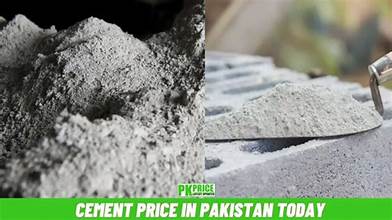Cement is one of the most crucial materials driving Pakistan’s construction sector. From small-scale housing schemes to mega infrastructure projects, the demand for cement remains consistent throughout the year. However, what truly shapes the industry is the fluctuation in cement prices, which directly influences real estate, commercial construction, and even day-to-day renovation work. In September 2025, cement prices across Pakistan have shown a notable decline, creating ripples in the market and drawing attention from builders, policymakers, and consumers alike.
This drop comes at a time when Pakistan is facing challenges of inflation, high fuel costs, and fluctuating economic conditions. For many, the reduction in cement prices provides temporary relief, but experts are closely examining the reasons behind the decline and its long-term sustainability.
Understanding the Decline in Cement Prices
The cement industry in Pakistan has always been sensitive to shifts in energy costs, raw material availability, and government regulations. Prices of cement typically rise when fuel costs soar or when supply chains are disrupted. Conversely, a decline in prices often signals improved supply conditions, reduced input costs, or slowed demand.
In September 2025, several key factors are driving the reduction in cement prices:
- Stabilization of Coal Prices
Cement manufacturers rely heavily on coal as a fuel source for kilns. With international coal prices stabilizing after a volatile period, production costs have eased, enabling manufacturers to reduce prices. - Improved Local Production
Several cement plants across Punjab and Khyber Pakhtunkhwa have increased efficiency, producing higher quantities. This improved local supply has prevented shortages and reduced dependency on imported raw materials. - Government Intervention
The government has been monitoring the construction materials market closely. Regulatory bodies have pressured cement manufacturers to stabilize prices to encourage infrastructure growth and housing affordability. - Reduced Construction Activity
Although the drop in prices benefits consumers, another reason behind the decline is a slowdown in construction activities. High inflation and rising interest rates have caused a temporary dip in demand, pushing manufacturers to adjust their pricing to maintain sales.
Regional Price Variations
Cement prices do not remain uniform across Pakistan. Costs often vary by region due to logistics, transportation, and proximity to manufacturing plants. In September 2025, the decline has been observed nationwide, but certain regions are benefiting more than others.
- Punjab: Being home to a large number of cement plants, Punjab has seen the sharpest reduction in cement prices. Builders in cities like Lahore, Faisalabad, and Multan are reporting more affordable rates.
- Sindh: Karachi and interior Sindh also experienced a price drop, though slightly less pronounced due to higher transportation costs from northern plants.
- Khyber Pakhtunkhwa (KPK): Local cement production has expanded in KPK, giving consumers better prices compared to last year.
- Balochistan: Owing to its limited industrial base and reliance on supply from other provinces, Balochistan still pays slightly higher rates, though the September decline has offered some relief.
Impact on the Construction Sector
The construction industry is highly sensitive to the costs of key raw materials. Cement, being the backbone of concrete, masonry, and structural development, plays a pivotal role. The September 2025 price drop carries both opportunities and challenges.
Positive Impacts
- Affordable Housing: Lower cement prices reduce the overall cost of construction, making housing projects more affordable for middle-class families.
- Boost for Infrastructure Projects: Ongoing projects like dams, highways, and urban development schemes may benefit from cost savings, ensuring timely progress.
- Encouragement for Renovations: Small-scale builders and homeowners are more likely to start renovation or expansion projects when cement is cheaper.
Challenges
- Temporary Decline in Demand: If prices have fallen primarily due to reduced construction activity, the industry may face a slowdown despite lower costs.
- Sustainability Concerns: Manufacturers may struggle to maintain lower prices if international fuel or raw material costs rise again.

Cement Prices and Inflation
Inflation remains one of the most pressing concerns for Pakistan’s economy in 2025. Everyday commodities, fuel, and services have seen steady increases in price. The decline in cement costs, therefore, provides a welcome exception. However, experts caution that the impact on overall inflation is limited, since construction materials form only one segment of the consumer price index.
Still, for industries tied to construction—such as steel, tiles, paints, and furniture—the cement price drop could create a ripple effect, easing costs for end consumers.
Market Outlook for the Coming Months
While September 2025 brought relief, analysts predict mixed trends for the remainder of the year:
- Short-Term Stability: Prices are expected to remain stable in the near future, thanks to steady coal supplies and moderate demand.
- Potential Rebound: If the government pushes forward with major housing schemes or CPEC-related projects, demand could rise sharply, pushing prices upward again.
- Global Economic Shifts: Any sudden increase in global fuel or coal prices may reverse the recent decline, highlighting the industry’s vulnerability to external shocks.

Consumer Perspective
For ordinary citizens, cement prices translate directly into the cost of building or repairing homes. A 50-kg cement bag’s price drop may seem small, but when multiplied across thousands of bags required for a single house, the savings become significant.
Consumers, however, remain cautious. Many still fear sudden price hikes, which are common in the industry. Therefore, some are choosing to stockpile cement while prices are low, further influencing market dynamics.
Role of Government and Industry Collaboration
The government and the cement industry must work hand in hand to maintain a fair and competitive market. Regulatory bodies can ensure price stability by monitoring manufacturers, while also encouraging investment in local production to reduce reliance on imports. Furthermore, subsidies on energy for cement plants could help sustain lower prices in the long run, supporting both industry and consumers.
Conclusion
The decline in cement prices across Pakistan in September 2025 has brought much-needed relief to an economy struggling with inflation and high living costs. While the reduction benefits construction projects, homeowners, and the real estate sector, it also signals challenges linked to reduced demand and the industry’s reliance on volatile global markets.
Going forward, the true test will be whether Pakistan can sustain affordable cement prices while boosting construction activity. For now, builders, contractors, and consumers alike are welcoming the September decline, hoping it marks the beginning of greater stability in one of the country’s most vital industries.



